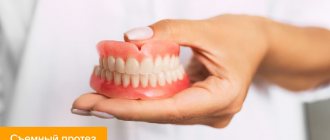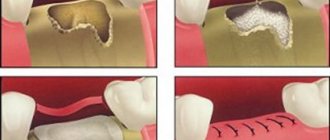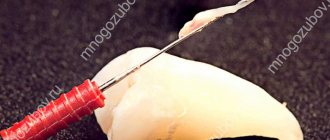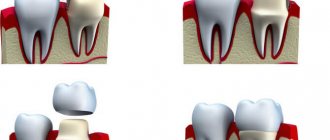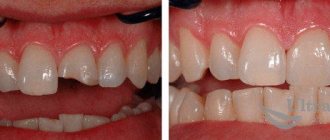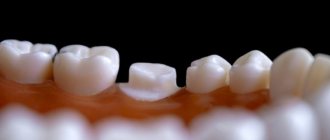The loss of a front tooth is very acute. And this is not surprising. Even if there is a slight darkening of the enamel on the front incisors, the person already begins to feel uncomfortable - he is embarrassed to talk and smile. And the absence of even one tooth along the smile line only aggravates psychological discomfort. Therefore, such problems need to be solved as quickly as possible.
Prosthetics for anterior teeth
are primarily aimed at high aesthetics. Therefore, they use materials that effectively combine strength and high aesthetic characteristics. The Ilatan Clinic in Moscow uses various methods for restoring front teeth using advanced technologies and the latest generation materials. Treatment methods and cost depend on the clinical picture.
Problems arising from missing teeth
The absence of even one dental unit in a row leads to serious consequences:
- Due to the lack of lateral support, neighboring teeth begin to shift;
- if a tooth is lost along with the root, the bone tissue in this area begins to quickly atrophy and decrease;
- chewing function is impaired, which leads to problems with the gastrointestinal tract;
- the bite changes, which leads to deformation of the position of the jaw joint and dysfunction of the umbilical nervous system;
- The shape of the face changes, the upper lip begins to recede, and wrinkles appear.
The longer a tooth is missing, the more severe the consequences will be. If a tooth is lost in the smile area, patients are offered different options for restoring the dentition. The method depends on the clinical picture.
Causes of loss of back teeth
The most common cases of loss of chewing teeth are neglected and untreated dental diseases: caries
, which developed into
pulpitis
or periodontitis, due to which the tooth had to be removed.
In addition, teeth (any teeth, including chewing ones) can fall out due to gum disease - periodontitis
or
periodontal disease
- in both diseases, the roots of the teeth become loose and do not hold in the inflamed gums.
Hormonal (for example, during pregnancy) or age-related changes also often lead to tooth loss.
Chewing teeth can also fall out due to prolonged wearing of bridges. When installed, such dentures are attached to adjacent teeth (most often to the posterior chewing teeth), and over a long period of wear they become loose. That is why bridge structures in modern dentistry are increasingly giving way to more advanced types of tooth replacement.
In the rarest cases, an end defect occurs in children at birth - when the rudiments of the back teeth were not formed at the stage of formation of the skeletal system. This happens mainly due to hereditary factors. You should also monitor your child’s primary chewing teeth – their premature loss can lead to the loss of the back molars.
One way or another, any lost tooth must be replaced as soon as possible, and the first step in this will be a timely visit to an orthopedic doctor.
On a note!
Currently, in As-Stom dentistry there is
a 15% discount
on all dentures and
a 50% discount
on an implant with installation. Both dentures and implants are excellent options for replacing lost back teeth.
Aesthetic restoration of anterior teeth
If you need to correct the appearance and shape of incisors or fangs, the best solution is ultra-thin veneers or lumineers. Plates 0.2 - 0.3 mm thick made of ceramic or zirconium are fixed to the outside of the teeth, eliminating all visual defects, making the smile luxurious. Such microprostheses do not require significant intervention in the structure of the teeth. The enamel is prepared exactly to the thickness of the plate, and the veneers are fixed to the surface of the teeth using a special glue (bond). Typically, veneers are installed on 6-10 upper and 4-6 lower teeth along the smile line.
Reason 1 – digestive problems
The digestion process begins in the mouth, when crushed and chewed foods are moistened with saliva containing certain enzymes. As a result, a formed and pre-processed food bolus enters the stomach. In the absence of chewing teeth, food is not crushed enough and is poorly saturated with saliva. As a result, stomach cells have to produce more hydrochloric acid, which increases the risk of developing gastritis.
The inability to chew food thoroughly leads to a change in diet. A person who does not know whether to insert teeth is trying to adapt to existing defects; he tries to eat more soft, pureed or liquid foods. This contributes to dystrophy of the oral mucosa, dysfunction of the digestive glands, decreased peristalsis, and changes in the microbial composition of the intestine.
If the front tooth is destroyed, but the root is preserved
In case of significant destruction of the coronal part (up to 50%), the front tooth can be restored using prosthetic crown. The affected tooth is depulped, followed by filling the canals, given the desired shape (prepared), if necessary, the root is strengthened with a stump insert. The crown is fixed onto the prepared stump using dental cement.
For the smile area, it is better to choose all-ceramic or metal-free crowns made of zirconium or aluminum oxide. These materials have a shade and degree of transparency similar to natural enamel. The doctor will select an option so that the restored tooth does not stand out in any way in the general row.
Reason 5 – aesthetic side
If a person refuses to insert the front lower or upper teeth, then the cosmetic defect will be significantly pronounced. In addition to visual changes, speech also suffers, the pronunciation of certain sounds is disrupted, and in some cases the patient’s appearance also changes. Since the dentition is a support for the soft tissues of the face, when this support disappears, sagging or sunken cheeks appear, facial features change, and asymmetry appears. All this leads to psychological problems, self-doubt, isolation, and fear of appearing in public. The longer the defect exists, the more pronounced these problems become.
With complete absence of a tooth
Prosthetics for front teeth in the absence of them involves 2 main methods:
- Installation of a bridge prosthesis
- this method is suitable for replacing 1 to 4 missing incisors. A bridge is a structure of several connected crowns, 1-2 suspended in the center and 2 hollow on the sides, which are attached to adjacent supporting teeth. The main disadvantage of the method is the need to grind and often depulpate the supporting units, even if they are completely healthy. That is, if you need to restore 1 missing incisor, two adjacent ones will have to be injured. - Implant prosthetics
– technology allows you to restore any number of missing teeth in a row. An implant is implanted into the jawbone, which fully replaces the missing tooth root. After the implant has healed, an adapter (abutment) is installed on it, onto which an artificial crown is fixed, identical in shape and color to the natural tooth. If an entire segment of the dentition is missing (3 or more teeth), 2 artificial roots are implanted, onto which a bridge is fixed. - Prosthetics of the front tooth immediately after extraction
is performed using the express implantation method. Immediately after surgical removal of a tooth, an implant is screwed into its socket, an abutment and a temporary crown made of lightweight plastic are fixed onto it. The temporary crown is removed from the bite, does not take part in chewing, it is necessary only to preserve the aesthetics of the smile. After 2-3 months, when the implant has fused with the bone, the temporary prosthesis will be replaced with a permanent one made of durable, reliable material (metal-ceramics, zirconium, etc.).
Prosthetics on implants does not involve injury to neighboring units; implanted implants perform all the functions of a natural tooth root and prevent jawbone atrophy. Implants are implanted once and for all; only prosthetic structures are subject to replacement (if they break or end their service life).
What to do with a knocked out tooth?
A “lost piece” that has fallen into snow, mud or autumn slush can only be rinsed with water, but cannot be scraped and cleaned “to a mirror shine” so as not to damage the still living fibers. For the same reasons, you should pick up the tooth by the crown, and not by the root, which will be re-engrafted into the hole. Disinfection of living tissue with alcohol or hydrogen peroxide is also prohibited.
After dislocation, the tooth should be kept in a moist environment, which will significantly increase its chances of replantation and healing. How to achieve this?
- The best natural medium that supports the vitality of a lost tooth is saliva. Therefore, the tooth can be placed in the mouth, on the opposite side from the damaged side, tucked between the cheek and gum. When a baby tooth is dislocated, a child may scream and cry. To prevent the tooth from being swallowed, its transportation can be handled by an accompanying relative—preferably the mother.
- Perhaps the adult victim or those around him have a container for storing contact lenses. The tooth can be placed in the saline solution it contains.
- A small container filled with water or milk will also work.
- If there is a pharmacy in the neighborhood, you can buy any drug that represents a physiological environment - glucose, 0.02 percent furatsilin, novocaine, etc.
First actions
If the tooth left its natural “habitat” unharmed, and you managed to find it, then you can count on the restoration of the unit. Find a small container, pour saline solution and place the tooth there. If you don’t have the necessary items on hand, you can wrap the unit in regular cloth or cotton wool. If possible, place a special cold pack next to the unit; it can be purchased at a pharmacy. In extreme cases, use ice.
If there is no heavy bleeding, it is enough to treat the oral cavity with any antiseptic liquid, Miramistin or Chlorhexidine will do. If there is severe pain, take any painkiller tablet, for example, Nise or Ketarol.
In case of heavy bleeding, you should immediately visit a doctor or call an ambulance.
Do I need to insert a tooth myself?
In case of incomplete dislocation, the crown that protrudes strongly from the gums at the scene of the incident can be carefully inserted into place without applying significant effort. This will prevent complete tooth loss, the likelihood of which is quite high. But you shouldn’t touch a knocked-out baby tooth; it’s better to quickly go to the dentist to identify possible damage to soft tissue and bone.
If a piece of a tooth breaks off, you should rinse your mouth with clean water, try to find the fragment and rush to see a qualified doctor.
In what cases does restoration not make sense?
Many of our patients ask this question. We always answer objectively when it is really worth investing not in restoring your own tooth, but in installing an implant. Of course, there is no clear solution, because each clinical case is individual, but there are many situations where we know for sure that installing an implant will be a much better solution for the patient, both for clinical and financial reasons.
- If the front tooth has already undergone endodontic treatment several times (especially if the treatment was carried out under a microscope), and there are still inflammatory changes in the area of the root apexes, there is no point in treating the root canal again, but it is better to remove the tooth and insert an implant.
- A similar situation occurs when we have a severely damaged coronal part of the tooth due to a subgingival fracture of the tooth, or when a carious cavity reaches the root of the tooth and prosthetic reconstruction using a coronal inlay and a prosthetic crown is very doubtful. In such a situation, it is also better to consider the option of implantation.
Pros and cons of temporary solutions
The advantages of temporary orthopedic structures are as follows:
- fast production,
- quite good aesthetics at first,
- low cost.
The disadvantages include, first of all, not very reliable fixation - even non-removable temporary ones can come off and fall out while chewing food. The disadvantages include low strength and rapid loss of aesthetics. Since the surface of plastic and composite materials is porous, food deposits, pigments, and microbes settle on it - and it is impossible to bleach the product to its original appearance.
Is it difficult to get used to dentures?
The process of adaptation occurs almost imperceptibly if the orthopedic design is as close as possible in shape and size to the lost natural tooth. For example, classic artificial crowns, bridges or dentures on implants do not cause discomfort after installation - especially if the tooth was lost recently. It takes several weeks to get used to removable “butterflies”, because... artificial gums and clasps seem foreign. To speed up adaptation, you can recite tongue twisters, read poems, and stories out loud.
“I very quickly got used to my metal-ceramic crown. She just fit in perfectly. And there were no unpleasant sensations at all. On the contrary, I was getting used to the fact that I was finally comfortable chewing and it didn’t hurt. You can say that I got used to the feeling of happiness, that everything is normal in my mouth now.”
Tatiana S., review from gidpozubam.ru
The cost of restoring a smile
The cost of prosthetics depends on what type of prosthetics was used, what materials were used, whether additional manipulations were necessary - treatment, root removal. So, for example, prices for metal-ceramic crowns start from 7,000 rubles, ceramic ones - from 20 thousand, zirconium dioxide - from 25 thousand rubles. Installing an implant will cost at least another 20-30 thousand. Temporary orthopedic structures cost from 2,000 rubles.
1Goldstein R. Aesthetic dentistry, 2003.
Your questions and answers
QUESTION Hello, my front side tooth is broken. And it broke almost at the root. From the outside it is very noticeable. What is the best way to “fix” it? Or just delete, and there are no other options? Vladislav K.
ANSWER Hello, Vladislav. If the root of a broken tooth is healthy, then it may well serve as a support for a prosthesis. But you can find out more about this at a face-to-face appointment with a dentist, because... you need to take an x-ray and see “what’s inside.” Further, as for the “repair” - prosthetics, you can install a crown (preferably ceramic) supported by a pin or stump inlay. But even if the dentist insists on removal, do not rush to install a regular bridge, because... it will require the use of 2 healthy teeth at the edges. You will have to grind them down and remove the “nerve” - this will reduce the service life of the supporting teeth. Plus they will be overloaded. Therefore, if removal cannot be avoided, then the ideal option is an implant with a crown on top.
Author: Chorny S.V. (Thank you for your help in writing the article and the information provided)
Are there any restrictions for dental prosthetics without grinding?
Like many other orthodontic procedures, this one has its limitations and contraindications. These include:
- Presence of cancer.
- Mental disorders.
- Problems with the cardiovascular system.
- Blood diseases (poor clotting).
- Physical exhaustion, weakness due to recent illnesses and attacks.
- Presence of sources of infection in the oral cavity.
- Inflammation in the gums.
- An allergic reaction to the material from which the prosthesis is made.
These are the main points that should be taken into account when installing prostheses without contact.
So, the types of prosthetics, contraindications have already been described above, and the advantages and disadvantages of non-contact installation of a prosthesis have been indirectly mentioned.
